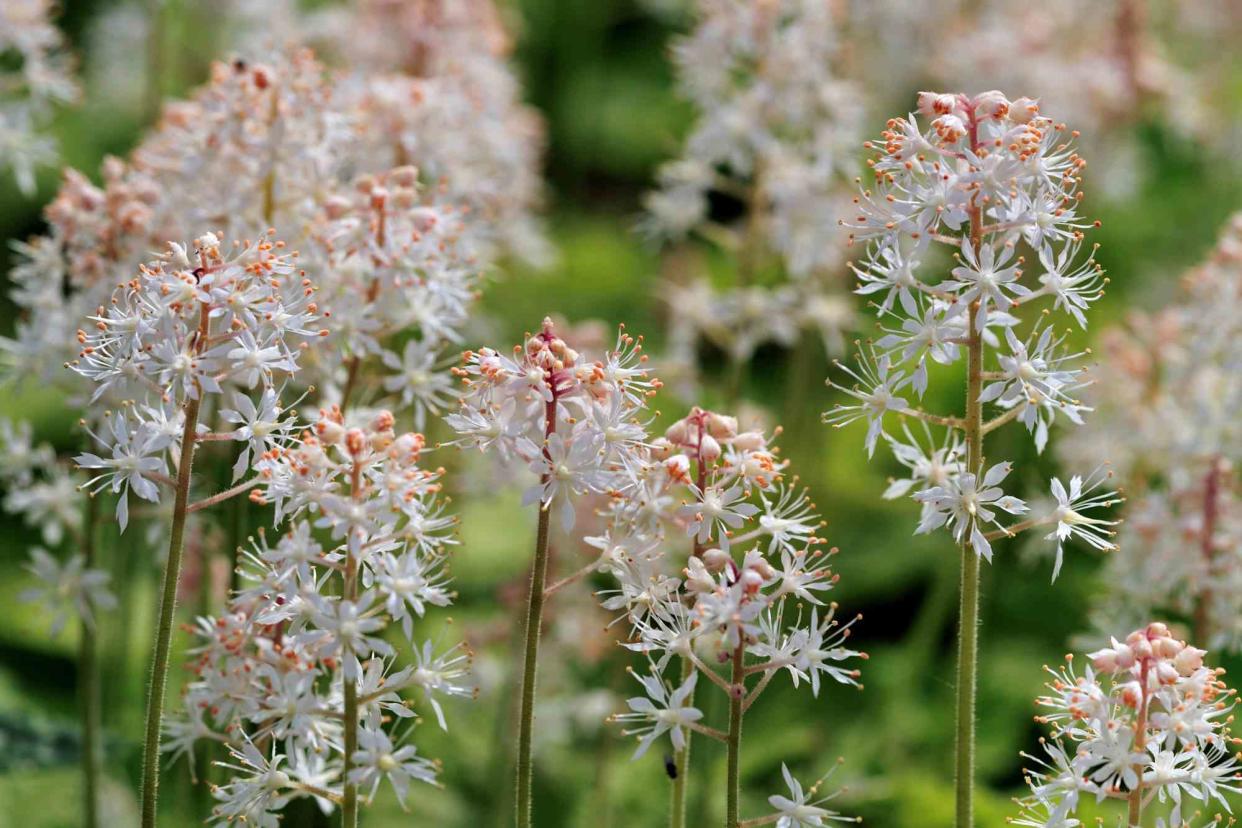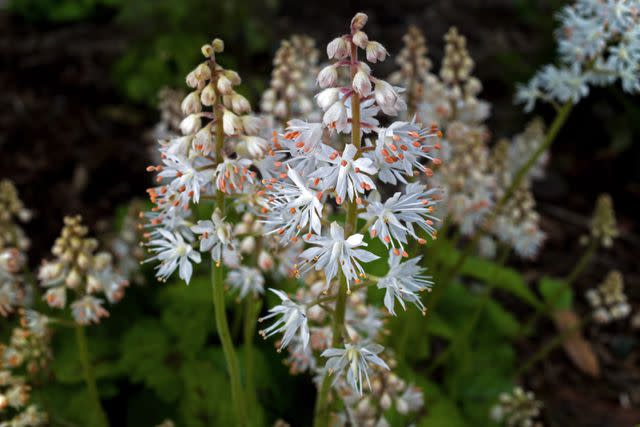How to Grow Tiarella (aka Foamflower), a Pretty Flowering Ground Cover for All Your Shady Spots
Foamflower tolerates the shade, loves moist soil, and doesn't need pruning to thrive in your garden.

Tiarella (Tiarella cordifolia), commonly known as foamflower, is a shade-loving plant that produces long-lasting blossoms. Native to the eastern United States, foamflower grows wild in forests and woodlands—and makes a beautiful garden plant. When in bloom, long stems shoot out with spire-style flowers that add vibrancy to any garden in late spring and early summer, depending on the cultivar.
The flowers, which bloom for about a month to a month and a half, are reminiscent of foam, giving this plant its namesake. "Folks looking for early season interest will love the spring blooms, which literally look like a spire coated in white or pink-tinged foam," says Megan Foster, category manager overseeing perennials and bulbs for AmericanMeadows and a member of the National Garden Bureau. If you're interested in growing and caring for foamflower, we spoke with experts to explain the best ways for this plant to thrive in your garden.
Meet Our Expert
Megan Foster, category manager overseeing perennials and bulbs for AmericanMeadows and a member of the National Garden Bureau
Tabar Gifford, master gardener and customer experience and partnership cultivator for AmericanMeadows
Allison Zeeb, account and product manager, home gardening for SAHIN Home Garden and National Garden Bureau member
Related: 15 Shade-Loving Perennials to Brighten Up Your Garden
Where and When to Plant Foamflower

Alex Manders
These plants love the shade. Plant them in a partially or fully shaded area to mimic their native habitat. "Foamflower is a reliable and easy-care woodland plant that is a great addition to a shady garden area bringing a whimsical bloom to the spring garden," says Tabar Gifford, master gardener and customer experience and partnership cultivator for AmericanMeadows.
Foamflowers complement many types of landscapes, including ornamental, wildflower, and woodland gardens. When growing from seeds, sow them in early spring after the last frost or in the fall or plant seedlings, small plants, sometime in the spring so they have time to get established. Plant seedlings by digging a hole with a depth and width a bit larger than the root ball.
How to Plant Foamflower From Seed
You can also start foamflower by planting seeds. This method can take some time as these plants are slow to grow. Sometimes, seeds can be sterile, depending on the variety. You can collect seeds after the flowers die back. "These seeds can be planted indoors or out, but they do take a while to grow, so being patient is key," says Gifford.
In early spring or fall, sow seeds directly in the soil and cover lightly.
Gently water and ensure the soil is moist but not soaking wet.
Be patient. Germination can take a couple of weeks to three months based on geographical regions, seed viability, and how you plant them.
Related: 12 Ground Cover Plants That Will Fill in Negative Space and Suppress Weeds in Your Garden

How to Propagate Foamflower
Love foamflower in your garden and want to grow more? It's easy to propagate by division. You can use this method once your foamflower is well-established and has ample roots. When you propagate a plant by division, you're digging up its roots and dividing and separating them to create new plants.
Carefully dig and pull out clumps and separate them.
Plant each division in a shady spot one to two feet apart.
Caring for Foamflower
Foamflower is easy to grow as long as its basic needs are met.
Sunlight
Since it is native to forest and woodland areas, foamflower is accustomed to receiving little to no sun and prefers it that way. Plant in a shady area for foamflower to thrive. "Foamflower is a woodland wildflower that thrives in moist forest settings with dappled sunlight as an understory plant," says Foster.
Related: 9 Summer Flowers That Thrive in the Shade
Soil
These flowers like nutrient-rich soil full of organic matter. "Think of the rich humus regularly found in its native range of eastern North American forests with generations of decomposed leaf litter, moist but well drained," says Foster.
Moisture and Watering
These plants like moist soil but never sopping wet. "If there’s standing water or soggy soil you may see some root rotting occur," says Gifford. You don't want to overwater or be too lax and forget to water them. "They don’t tolerate extended drought well either," she says. Keeping the soil moist will help foamflowers establish a strong root system during the first growing season, says Allison Zeeb, account and product manager, home gardening for SAHIN Home Garden and National Garden Bureau member.
Fertilizing
Foamflowers don't need fertilizer when they are planted in a nutrient-rich, well-draining soil. If you choose to use fertilizer, do so before new growth begins in the early spring. Zeeb says you can apply "a single application of a balanced, general-purpose fertilizer in early spring when new growth appears." She recommends a granular slow-release fertilizer that has an equal ratio of nitrogen, phosphorus, and potassium.
Related: How to Make Homemade Fertilizer Using Common Kitchen and Garden Scraps
Pruning
Foamflower is a pretty low-maintenance plant, so you typically don't need to do a lot of pruning. You should trim dead leaves to allow for new growth in the spring and cut back dead flowers for optimal health.
Common Pests
When foam flowers are grown in their preferred environment and proper soil, you don't have to worry about pests and diseases. "Foamflowers are generally not affected by disease or pests," says Gifford. Slugs and snails may visit on occasion and can be easily removed by hand. Deer and rabbits are often the usual suspects to munch on your plants and flowers but with astringent-flavored leaves, they usually avoid foamflower. "The exception being if they are starving and lacking food sources, rabbits and deer may eat anything (even if it’s unpleasant or even poisonous)," says Gifford. "This makes them a reliable and easy-to-grow shady-loving favorite for woodland gardens."
Related: 5 Expert-Approved Ways to Keep Animals Out of Your Garden
Read the original article on Martha Stewart.
